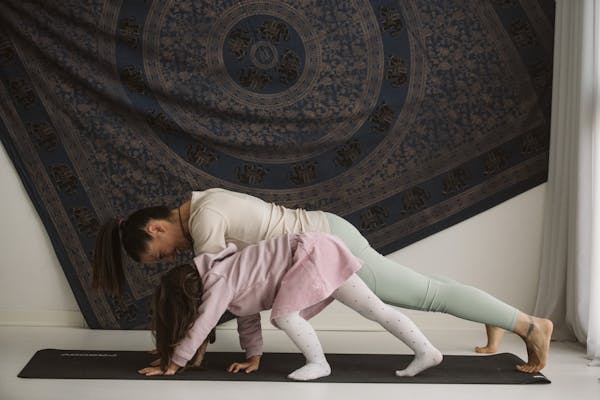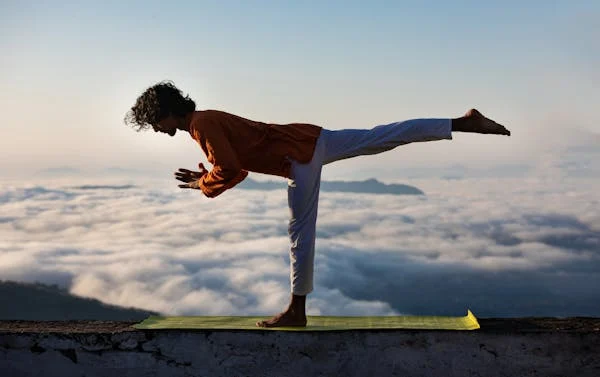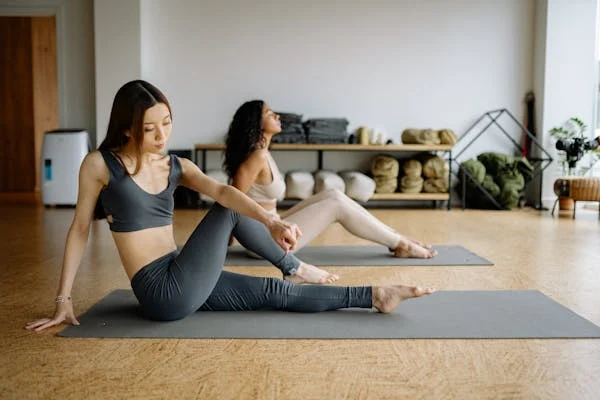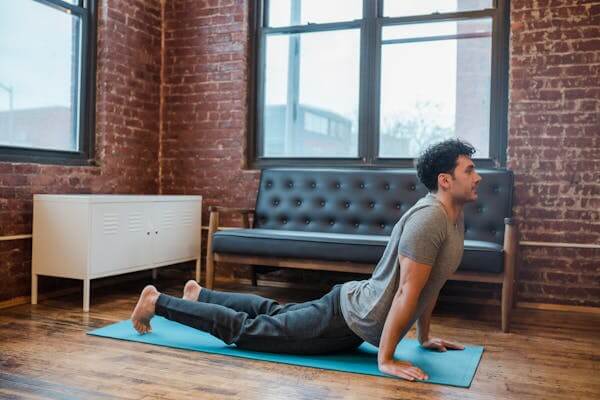Table of Contents
Power Yoga is an ancient practice rooted in Indian tradition, which has evolved over centuries to accommodate the dynamic lifestyles of modern individuals. Among its various forms, Power Yoga stands out as a transformative and powerful yoga practice that combines physical intensity with the meditative essence of traditional yoga.
This blog explores how Power Yoga can be your ultimate tool for achieving strength, flexibility, and overall well-being.

Understanding Power Yoga
Power Yoga was developed in the United States in the 1990s as a western adaptation of the traditional Ashtanga Vinyasa Yoga system. It is meant to have the same spiritual core of yoga but work out hard.
Unlike traditional yoga, Power Yoga is fast-paced, dynamic, and more fitness-oriented. It focuses on fluid movements that are synchronized with breathing patterns, creating a seamless flow of poses. This practice has gained immense popularity as a powerful yoga workout that builds physical endurance and mental resilience.
Key principles of Power Yoga include:
Breath Control: Synchronizing breath with movement.
Strength Training: Engaging muscles to hold poses for extended periods.
Flexibility Enhancement: Deep stretches to better range of motion.
Mindfulness: Focus on each movement as well as breath to make the mind clear.
Benefits of Power Yoga for Strength and Flexibility
Power yoga is famous for its advantage of building strength as well as flexibility
1. Building Strength Through Power Yoga
Power Yoga contains a wide range of exercises that work on different muscle groups, thereby acquiring functional strength. The postures of Plank Pose, Warrior Pose, etc., demand a good amount of holding and thereby strengthen limbs and develop strength in both muscles as well as bones, thus preventing injuries.
2. Flexibility:
Dynamic stretches and transitions in Power Yoga are a significant improvement of flexibility. Stiff muscles of Downward Dog and Camel Pose target the elasticity and range of movement. This makes Power Yoga a very strong routine for flexibility, in which practitioners feel lighter and agile.
3. Improving Balance and Stability
Balancing postures such as Tree Pose and Warrior III challenge the body coordination and stability. Regular practice enhances proprioception, an awareness of body position, necessary for a person to maintain physical balance.
4. Building Endurance and Cardiovascular Health
Power Yoga allows for an intense flow that has the heart rate raised, delivering cardiovascular benefits similar to those of aerobics. It builds up stamina, thus making this a great activity for sportsmen and people who aim to be fit.
This kind of power yoga is distinctive because of its focus on putting together mental effort with the physical practice. Below are its hallmark characteristics:
1. Dynamic Vinyasa Flow
The heart and soul of Power Yoga lies in its Vinyasa flow as every movement corresponds to a breath in or out of the body. Thus, creating a rhythm, which helps make the exercise meditative yet physically rigorous—a full-fledged experience.
2. Intensity and Calorie Burn
Power Yoga is more vigorous than traditional yoga styles, making it ideal for those seeking a high-intensity workout. It burns calories efficiently, aiding in weight management.
3. Accessibility for All Levels
Although it is intense, Power Yoga can be adapted for beginners and advanced practitioners alike. Modifications allow participants to progress at their own pace.


Essential Power Yoga Poses for Strength and Flexibility
Here are some of the fundamental postures in Power Yoga that can help describe its powerful nature of yoga:
1. Chair Pose (Utkatasana)
Strengthening: Legs, core, and back.
How to Practice: Stand tall, bend your knees as if sitting in an invisible chair, stretch your arms overhead. Hold for 5-10 breaths.
2. Warrior Series (Virabhadrasana I, II, III)
Strengthening: Legs, arms, and core.
How to Practice: Flow between Warrior I, Warrior II, and Warrior III. Pay attention to alignment and balance.
3. Downward Dog (Adho Mukha Svanasana)
Increases Flexibility: Stretches hamstrings, calves, and spine
How to Practice: Start in a plank position, then lengthen your hips up towards the ceiling, creating an inverted V.
4. Plank Pose
Strengthens Core: Engages abdominal muscles
How to Practice: Keep a straight line from head to heels with engaged core.
5. Camel Pose (Ustrasana)
Improves Flexibility: Opens the chest and stretches the spine.
How to Practice: Kneel, place hands on your heels, and arch your back while keeping your neck relaxed.
Who Can Practice Power Yoga?
Power Yoga is versatile and suits a wide range of individuals. However, certain considerations apply:
1. Suitable for Most Age Groups
Teens, adults, and seniors can benefit from Power Yoga, provided they choose poses appropriate for their fitness levels.
2. Precautions for Beginners
Start with guided classes or tutorials for proper technique. Modifications make difficult poses accessible.
3. Medical Conditions to Consider
People with chronic diseases, joint problems, or injuries should consult a doctor before beginning Power Yoga.
Tips for Getting Started with Power Yoga
1. Create a Comfortable Space
Find a quiet and spacious area for uninterrupted practice. Use a quality yoga mat for support.
2. Warm-Up Before Practice
A light warm-up prepares the body for the intense movements of Power Yoga.
3. Join Class or Video Lessons
Enroll in a class or follow online tutorials to learn the correct techniques.
4. Gradually Improve
Avoid overexertion and build endurance slowly. Listen to your body’s cues to prevent injuries.
How to Include Power Yoga in Your Life
1. Schedule Practice Sessions
Spend 30-60 minutes, 3-5 times a week, on Power Yoga. It is also invigorating to do in the mornings.
2. Mix with Other Exercises
Power Yoga pairs well with strength training and cardio exercises as a complete fitness regimen.
3. Set Realistic Goals
Monitor your progress in terms of strength, flexibility, and mindfulness. Small achievements will keep you motivated.


How Power Yoga Improves Mental Strength
While Power Yoga is popularly known to enhance physical well-being, it is equally effective in mental well-being. This powerful yoga practice requires complete attention and awareness, which cultivates mental strength.
1. Reducing Stress and Anxiety
Power Yoga involves controlled breathing (pranayama) that helps calm the nervous system. It induces a meditative state with a rhythmic flow of postures and breathing. The stress and anxiety are diminished.
2. Building Self-Esteem
Perfecting difficult Power Yoga poses develops a feeling of accomplishment. This increased self-esteem will spill over into other walks of life, and those practicing Power Yoga will become better equipped to face issues with a positive attitude.
3. Improving Cognitive Acuity
The focused nature of Power Yoga cleans out mental clutter. It increases mindfulness, which sharpens concentration and improves decision-making abilities.
Common Myths Surrounding Power Yoga
As is any popular fitness trend, myths surround Power Yoga. Let’s debunk a few so that you have a clearer picture of what the power yoga practice is.
1. Myth: Power Yoga is Only for the Young and Fit
Reality: The modifications in Power Yoga ensure all people with different fitness levels can adapt to it. Beginners as well as seniors can follow this practice safely and effectively.
2. Myth: Power Yoga is Just Another Workout
Reality: Although Power Yoga is indeed a very physical form of workout, it’s much more than that as it merges movement with mindfulness.
3. Myth: Power Yoga Does Not Focus on Flexibility
Reality: Power Yoga actually combines both strength and flexibility. Dynamic stretches and poses are an important part of the practice and ensure well-rounded physical development.
Absolutely! Let’s go deeper into Power Yoga to ensure full coverage of the topic.
How Power Yoga Boosts Mental Strength
Though Power Yoga is mainly considered a great physical exercise, it has equal benefits on the mental level. This dynamic practice of powerful yoga demands complete focus and presence, which helps in developing mental strength.
1. Stress and Anxiety Reduction
Power Yoga incorporates controlled breathing techniques (pranayama) that soothe the nervous system. The rhythmic flow of poses, with the use of focused breathing, can induce a meditative state, helping to relieve stress and anxiety.
2. Increasing Self-Esteem
Learning challenging Power Yoga poses gives a sense of achievement. This helps translate to other aspects of life as practitioners learn to tackle challenges in a more positive way.
3. Increasing Mental Acuity
It cleanses the mental clutter with the intense focus needed in Power Yoga. It encourages mindfulness, which sharpens concentration and enhances decision-making skills.
Common Myths About Power Yoga
Like any other popular fitness trend, Power Yoga is surrounded by misconceptions. Let’s debunk a few myths to give you a clearer understanding of this powerful yoga practice.
1. Myth: Power Yoga is Only for the Young and Fit
Reality: Power Yoga can be modified to suit every level of fitness. Modifying it makes it possible for new beginners and seniors to participate safely and effectively.
2. Myth: Power Yoga is Just Another Workout
Reality: Although Power Yoga provides an intense physical workout, the soul of Power Yoga is actually about linking movement with mindfulness, which makes it more than just exercise.
3. Myth: Power Yoga Doesn’t Emphasize Flexibility
Reality: Power Yoga incorporates strength and flexibility into it. Dynamic stretches and asanas are a part of the workout that helps in the balanced development of body and mind.
Power Yoga for Weight Loss
Power Yoga is a great option for someone looking for an efficient and fun way to lose weight.
1. Burning Calories
The high-intensity sequences of Power Yoga will raise the heart rate and burn a lot of calories. It is a very potent yoga workout for people who are trying to lose weight.
2. Developing Lean Muscle
Power Yoga is multitasking for your body to develop lean muscle, which gives way to higher metabolism and helps in weight maintaining.
3. Eliminating Stress-Related Eating
Being a stress-reduction method, Power Yoga reduces emotional eating by enhancing mental wellness and consciousness.
Power Yoga and Holistic Wellness
Well beyond developing strength and flexibility, Power Yoga also encompasses holistic health in the dimensions of physical and mental wellness.
1. Sleep Quality
This combination of meditative aspects with physical exertion helps the body sleep better. It will help calm the mind, get ready the body for restful sleep by practicing this powerful yoga routine in the evening.
2. Improving Digestion
Some Power Yoga poses stimulate the digestive organs, improve metabolism, and reduce bloating.
3. Immunity Boosting
Power Yoga practice will enhance immune function as it will help reduce stress and improve circulation, keeping the body’s defenses strong.


Conclusion
Power Yoga combines intense focus with mindfulness, therefore an ideal yoga practice to engage for physical and mental changes in a person’s body. It increases one’s strength, enhances flexibility, and gives a deep feeling of connecting the mind with the body.
Power Yoga is something with which anyone can have unlimited endless possibilities of progressing through it and challenging oneself while in the process. So, go ahead and add this powerful yoga practice to your life today. Witness some remarkable changes in your strength, flexibility, and overall well-being
